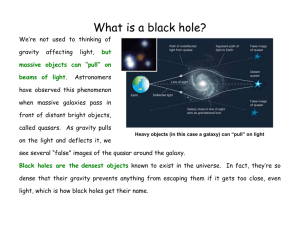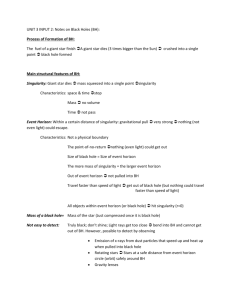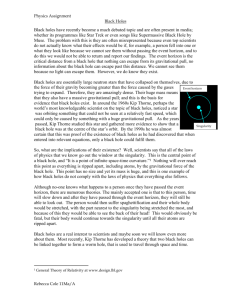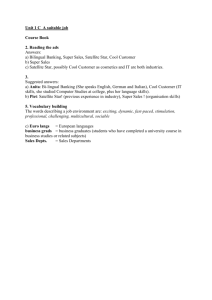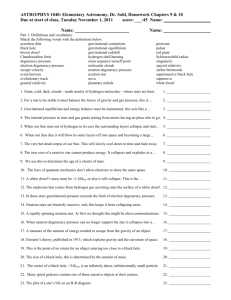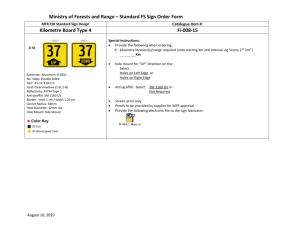GK-12 Sensors
advertisement
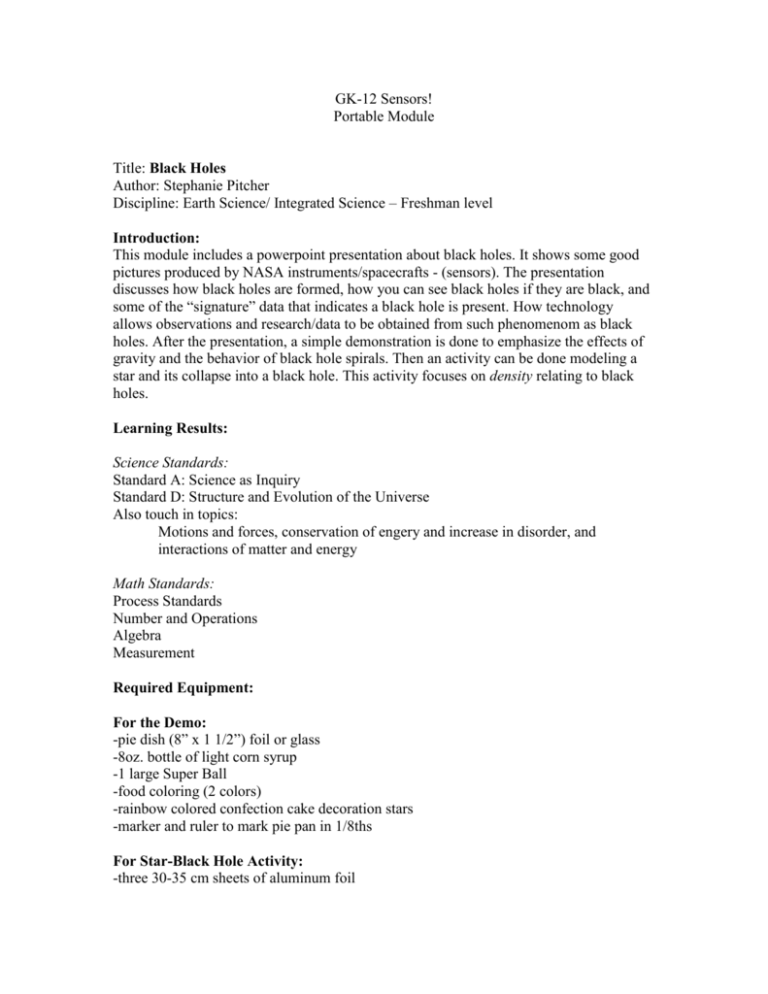
GK-12 Sensors! Portable Module Title: Black Holes Author: Stephanie Pitcher Discipline: Earth Science/ Integrated Science – Freshman level Introduction: This module includes a powerpoint presentation about black holes. It shows some good pictures produced by NASA instruments/spacecrafts - (sensors). The presentation discusses how black holes are formed, how you can see black holes if they are black, and some of the “signature” data that indicates a black hole is present. How technology allows observations and research/data to be obtained from such phenomenom as black holes. After the presentation, a simple demonstration is done to emphasize the effects of gravity and the behavior of black hole spirals. Then an activity can be done modeling a star and its collapse into a black hole. This activity focuses on density relating to black holes. Learning Results: Science Standards: Standard A: Science as Inquiry Standard D: Structure and Evolution of the Universe Also touch in topics: Motions and forces, conservation of engery and increase in disorder, and interactions of matter and energy Math Standards: Process Standards Number and Operations Algebra Measurement Required Equipment: For the Demo: -pie dish (8” x 1 1/2”) foil or glass -8oz. bottle of light corn syrup -1 large Super Ball -food coloring (2 colors) -rainbow colored confection cake decoration stars -marker and ruler to mark pie pan in 1/8ths For Star-Black Hole Activity: -three 30-35 cm sheets of aluminum foil -1 balloon -1 tape measure -1 scale (that weighs to a tenth of a gram) -1 graphics calculator Procedure: Demonstration: Setup Directions: 1. Using a ruler and a marker, draw lines to segment the pie dish into 8 equal sections 2. Pour ½ a bottle (8oz.) of light corn syrup to cover the bottom of the dish 3. Place the super ball in the center of the pie dish in the light corn syrup 4. Place 4 confection stars of different colors in a line to the left of the super ball 5. Place 4 confection stars of different colors in a line directly below the super ball 6. Place 1 drop of blue food coloring close, about ½ in., but not touching the right side of the super ball 7. Place 1 drop of green food coloring in front of first and last star on left side of the super ball **The experiement should start immediately after setup so the corn syrup does not stiffen** Procedure for Demo: Take turns slowly spinning the super ball (black hole) in a circle, always spinning it in the same direction and observe how space (corn syrup) and matter (stars, gases, particles) are affected by the black hole. Observe the twisting of space, formation of an accretion disk, as well as the orbiting and capture of matter. Also notice that the star(s) furthest away from the black hole remain stable. Procedure for Black Hole Activity: Procedure: 1. Blow up the balloon until the diameter is about 15 cm. Tie off the end. Cover the inflated balloon with the sheets of aluminum foil. This will be your “Model Star”. 2. Measure the circumference of the aluminum foil star. Repeat this 3 times using 3 different paths around the star. Calculated the mean of these 3 measurements. In your data table, record this average value as Trial 1 Circumference. 3. Place the “Model Star” on the scale. Record the mass (grams) under Trial 1 Mass. 4. Now Supernova! Break your balloon by squeezing it. Gently shape the aluminum foil back into a “sphere”. Measure the circumference of the now collapsed “Model Star” three times. Average these 3 measurements. Record the value as the Trial 2 Circumference. 5. Obtain the mass of the collapsed “Model Star” and record the value as Trial 2 Mass. 6. Squeeze the collapsed star a little more. Repeat the procedure for determining the new average circumference and record your data as Trial 3. 7. Repeat the mass measurement and record your value appropriately. 8. Squeeze the collapsed star so that you make it as small as you possibly can. Repeat the circumference and mass measurements and record the data. For each circumference, calculate the radius of the sphere. Remember, this is done by dividing the circumference by 2*. Record the results appropriately in your data table. 9. Now calculate the volume [(4/3)* *r3] of the sphere for each radius. 10. Calculate the density. Remember that density is defined as mass/volume. Expected results: Demonstration: While demonstrating, a description in detail will be given on the effects black holes have on nearby space. 1. What happened to space near the black hole? 2. What happened to the stars near the black hole? 3. What happened to the star furthest away from the black hole? Why? These concepts should be grasped, now that a visual demostration and discussion were performed. Activity: The outcome of this activity will allow students to understand the concept of density. How black holes form and the calculations and differences between circumference, radius, volume, mass, and density. They will learn that the density increases as the volume decreases, and the mass stays approximately the same. Troubleshooting: Demo: This can be really messy, therefore, I use it as a demonstration rather than an activity. But it could just as well be an activity for students. Activity: The biggest problem I’ve encountered is that the freshman get bogged down in the calculation part and not understand the overall outcome of what is happening as their model stars collapse and become more dense, and eventually turn into a black hole. To overcome this issue, just make sure there is enough time at the end to compare answers and ask them what they see happening according to their answers/calculations. Resources: NASA/GSFC workshop, summer 2003 http://imagine.gsfc.nasa.gov/docs/teachers/blackholes/blackholes.html

